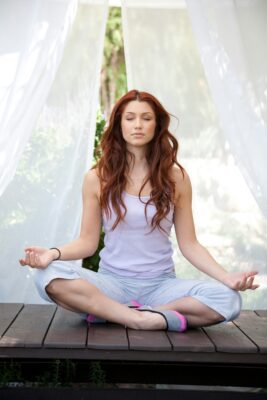Master Advanced Breathing Techniques for Better Health and Mental Clarity

Advanced breathing techniques have the power to enhance your physical and mental well-being by improving lung capacity, increasing oxygen flow, and promoting relaxation. While many people are familiar with basic breathing exercises, diving into advanced techniques offers a whole new realm of benefits, from stress relief to enhanced focus and athletic performance. In this guide, we’ll explore the best advanced breathing techniques, their benefits, and how to practice them for optimal results.
Why Practice Advanced Breathing Techniques?
Breathing is something we do naturally, yet when practiced mindfully, it becomes a powerful tool for mental clarity and physical health. Advanced techniques help:
- Increase oxygen intake, improving overall energy levels.
- Reduce stress and enhance relaxation through mindful control.
- Boost lung capacity, helping with endurance and physical performance.
- Promote mental clarity, making it easier to focus and manage anxiety.
- Strengthen the diaphragm, which improves posture and supports healthier breathing patterns.
Best Advanced Breathing Techniques
1. Diaphragmatic Breathing (Belly Breathing)
This advanced technique emphasizes deep breaths that engage the diaphragm rather than shallow chest breathing. It allows for full oxygen exchange, which slows the heartbeat and stabilizes blood pressure.
How to Practice:
- Sit comfortably and place one hand on your chest and the other on your belly.
- Inhale deeply through your nose, ensuring your belly rises more than your chest.
- Slowly exhale through your mouth, feeling your belly fall.
- Practice for 5-10 minutes.
Diaphragmatic breathing is perfect for reducing stress, improving lung function, and promoting relaxation.
2. 4-7-8 Breathing Technique
The 4-7-8 technique is an advanced method for calming the mind and reducing anxiety. This technique helps regulate breath flow and promotes a state of relaxation.
How to Practice:
- Inhale through your nose for 4 seconds.
- Hold your breath for 7 seconds.
- Exhale through your mouth for 8 seconds.
- Repeat for four cycles, gradually increasing the time as you improve.
This breathing exercise helps manage stress and improve sleep quality.
3. Ujjayi Pranayama (Ocean Breath)
Ujjayi Pranayama is an ancient yogic breathing technique often used in yoga practice to build heat and focus. It involves breathing through the nose while slightly constricting the throat, creating an ocean-like sound.
How to Practice:
- Inhale deeply through your nose.
- Slightly constrict the back of your throat and exhale through your nose, producing a “hissing” sound.
- Maintain a steady rhythm, keeping the breath smooth and even.
This technique enhances concentration and helps you stay centered during physical and mental activities.
4. Bhastrika Pranayama (Bellows Breath)
Bhastrika Pranayama, also known as Bellows Breath, is a powerful technique to energize the body and mind. It involves forceful, quick inhalations and exhalations through the nose to increase oxygen supply.
How to Practice:
- Sit in a comfortable position with your spine straight.
- Inhale deeply through your nose, expanding your abdomen.
- Exhale forcefully, contracting your abdomen.
- Repeat for 10-20 breaths and increase as you become more comfortable.
This breathing technique is excellent for boosting energy and clearing the mind.
5. Box Breathing
Popular among athletes and high-performance professionals, box breathing involves taking slow, controlled breaths with equal-length inhales, holds, and exhales.
How to Practice:
- Inhale for 4 seconds.
- Hold your breath for 4 seconds.
- Exhale for 4 seconds.
- Hold your breath for 4 seconds.
- Repeat for several minutes.
Box breathing is particularly effective for calming the nervous system and improving focus.
6. Breathing Techniques Wim Hof
The Wim Hof Method, developed by the “Iceman” Wim Hof, involves deep breathing exercises followed by cold exposure. The breathing portion focuses on taking rapid, deep breaths to oxygenate the body fully.
How to Practice:
- Take 30 deep breaths, inhaling through the nose and exhaling through the mouth.
- Hold your breath after the last exhale for as long as you can.
- Inhale deeply once you need to breathe again and hold for 15 seconds before exhaling.
- Repeat for 3-4 rounds.
This technique boosts oxygen levels and is often combined with cold therapy to improve mental and physical resilience.
Incorporating Advanced Breathing into Your Routine
While these breathing techniques are powerful on their own, they can be incorporated into your existing routines to enhance their benefits. Whether you’re practicing yoga, meditating, or simply looking to manage stress, these exercises can be tailored to fit your needs.
Tips for Successful Practice:
- Start slowly: Begin with shorter sessions and gradually increase the duration and intensity as you build strength.
- Be consistent: Make breathing exercises a part of your daily routine to maximize their benefits.
- Listen to your body: Pay attention to how your body responds to these techniques, and adjust accordingly.
Books to Deepen Your Practice
If you’re looking to explore advanced breathing techniques further, these books can offer valuable insights and practical exercises:
Breathwork: A 3-Week Breathing Program to Gain Clarity, Calm, and Better Health by Valerie Moselle – A step-by-step program to incorporate advanced breathing techniques into your routine.
Breath: The New Science of a Lost Art by James Nestor – This book delves into the science of breathing and its profound impact on health.
The Healing Power of the Breath by Richard Brown and Patricia Gerbarg – A guide to using breathing techniques to reduce stress and improve overall health.
Explore more breathing tools and accessories to enhance your practice on Amazon here.
This guide was brought to you by BreathingExerciseGuide.com.



